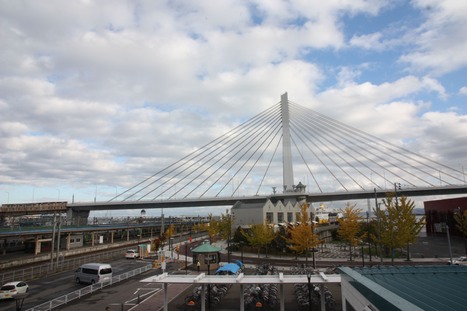Wednesday, 31 October 2012

The day kicked off with the close to regulation reasonably early (8:24 isn’t up there with the sparrows at first light but it isn’t exactly late either) departure from a station that the cool clear light of day showed to be right beside Aomori’s waterfront. There was a ferry that transports cars and passengers (presumably) to Hokkaido visible from the footbridge en route to Platform 6).
On the northern tip of Honshu, facing Hokkaido across the Tsugaru Strait, Aomori Prefecture has a number of tourist attractions, most of them nature related, though historic ruins including Sannai-Maruyama (Japan's largest, said to date back to 4,000 to 5,000 BC), Korekawa and Kame-ga-oka would have their share of appeal to the interested observer and Hirosaki Castle is a well-known cherry blossom venue.
Given our schedule (arriving around seven-twenty in the evening, off to take the tunnel under the Tsugaru Strait before eight-thirty the following morning), however, we were never going to be doing much looking around.
The city is a relatively recent development, dating back to the Edo period, when the Hirosaki clan began building a seaport and used woods nearby as landmarks for inward-bound shipping. The name Aomori either translates as blue or green forest and the name did not come into common use until after 1783 though there’s a counter theory that attributes it to an Ainu word, but there’s no doubt the town was an important stepping stone in the Japanese colonisation of Hokkaido.
As indicated, human occupation of the area goes back a ways, and it was part of the region ruled from Hiraizumi by the Northern Fujiwara clan during the Heian period, although it was still largely inhabited by the hunting and gathering Emishi people. Around the start of the Edo period, Aomori was a minor port settlement but in the administrative reforms that followed the Meiji Restoration various feudal domains were abolished and replaced with prefectures, a process that brought about the inauguration of Aomori prefecture on 23 September 1871. Aomori, however, wasn’t designated as a city until 1 April 1898.
You can’t help thinking those developments were related to the Japanese aim to bring the whole of the archipelago under Imperial rule and restrict foreign incursions, and within a year of the creation of Aomori Prefecture the Hokkaidō Colonization Office was operating a ferry service from Aomori to Hakodate. Ttwenty years later the opening of the Tōhoku Main Line connected the area with Tokyo by rail. The line we’d used to reach the city is slightly more recent, dating back to 1908.